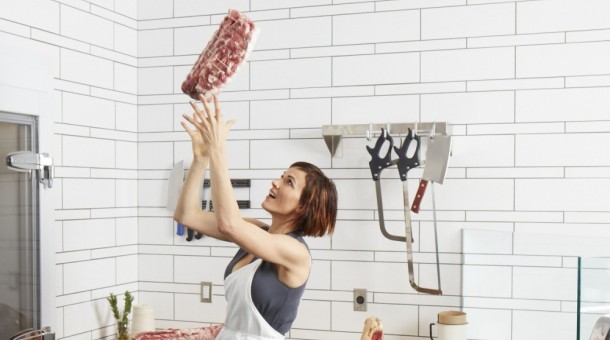

The sustainable-food maven's bold new venture goes from pasture to plate, with all the stops in between (yes, this means she runs her own slaughterhouse).
Ask Anya Fernald how she likes her burger, and her answer doesn't end with "medium rare." It's lunchtime at a sun-splashed Larkspur shopping plaza, and the Slow Food activist-turned-entrepreneur is sitting in her new butcher shop-cum-restaurant, ticking off her requisites for ground beef. Everything begins, she says, with pedigree cattle raised for at least two years on open pastures, where they develop marbled muscle before making the journey to a slaughterhouse devised to minimize their anguish and a butchery designed to maximize their use. In Fernald's ideal world, the choice cuts of each animal are set to age, and their less heralded parts are put to creative purpose, so that little of their fleshly being is left to waste. As for the sirloin that becomes hamburger, it's house-ground and served in modest portions, not the hulking patties of so many mainstream troughs. Oh, and she likes it on a sesame seed bun.
Having it her way has taken work, though. Seven years ago, when Fernald returned to California after an extended stint in Italy, she had such trouble finding meat that pleased her palate and eased her conscience that she seriously fretted, she says, about whether she would be able to buy meat at all. But where another carnivore might have retreated to a life of grains and legumes, she attacked the problem head-on.
The result of Fernald's efforts is the Larkspur Landing space in which she sits this afternoon. It's called Belcampo, the retail arm of a larger operation unlike any other in the United States -- one that includes not just a storefront but also a 10,000-acre farm in Shasta Valley and a slaughterhouse designed by animal welfare expert Temple Grandin. As chief executive officer of this multilayered business, Fernald enjoys a luxury unknown to other sustainably minded meat producers: control of every step in an animal's march to market. Forget farm-to-table. Think of it as pasture-to-processing-to-plate. "We're pretty much going balls to the wall here," Fernald says. "But if you want to do the right thing while delivering a consistently superior product, that's the way to do it. You've got to own more of the supply chain."